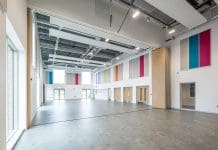PCSG Senior BIM Consultant, Steve Thompson, explains how digitalisation is opening up opportunities for a more circular economy approach
At PCSG we have for a while now been helping clients throughout the built environment to understand the potential benefits of a circular economy for construction, enabled by digital processes. With the rapid growth of digital awareness and technologies, solutions to many of the barriers to through lifecycle thinking are emerging.
“A circular economy is one that is restorative and regenerative by design, and which aims to keep products, components and materials at their highest utility and value at all times, distinguishing between technical and biological cycles.” – Ellen MacArthur Foundation.
Through the CPA’s recent report on the Future for Construction Product Manufacturing, we identified the need to consider digitally connected supply chains, and to link manufacturing, design and delivery of assets with performance in use. We need to consider how to deliver mass customisation of buildings (the ability to have unique, but economic and deliverable assets), along with construction flexibility and in-use adaptability if we are to optimise the lifecycle of a building.
Construction flexibility enables the same building to be constructed in a number of ways using the same components, and also to cope with changes in user requirements during the design and delivery phase of an asset.
In-use adaptability enables the building to be re-configured or adapted, regarding layout or performance through its lifecycle. As John Turner said, “an environment is an environment by virtue of the life that it surrounds”. The way a building is used over time can change significantly as occupant requirements change, whether a complete change of use from a home to an office for example or a change driven by the invention of new technologies, such as the invention of the refrigerator eliminating the need for a larder. By enabling a building to be reconfigured, we can potentially extend its lifecycle to maintain its suitability.
To achieve mass customisation, construction flexibility and in-use adaptability, we need to be able to share digital product information consistently all the way through the lifecycle of a project and an asset’s lifecycle. To do so, and to enable a circular economy, we also need to consider the product lifecycle, and how products can be designed, manufactured and installed ready to be re-used. Re-used not necessarily at the end of their useful life, but also the useful life in the context of the wider asset.
Disparate lifecycles in construction
To achieve a circular economy in construction, the three disparate lifecycles of building projects, built assets and construction products have to be integrated. All of these lifecycles currently include digital processes to some degree.

A construction project delivered to Level 2 BIM – a digital twin of the physical asset – is created which then supports its management throughout the asset’s operational phase.
The asset lifecycle entails the construction, maintenance, reconfiguration and eventual re-use or re-cycling of assembled products at the end of the asset’s life. A range of digital tools are deployed to manage this process.
A product lifecycle includes its design and development, procurement of materials, manufacture and then delivery and installation as part of a built asset. All of these require digital processes, which are not currently typically extended through the operational phase of an asset. Within the current fragmented construction industry, it is common for manufacturers to lose track of their products past the point of sale, leaving a significant gap in knowledge on where a product is, how it is performing in use and when it is ready for replacement or re-use. This gap can be filled using the likes of the CPA’s LEXiCON to consistently define and share product information all the way through the product and asset lifecycle.
Integration and optimisation of three life cycles
The CPA report describes how these lifecycles can be optimised through integrating the virtual and physical environments, with the potential to deliver assets up to 40% quicker and 30% cheaper.

Benefits from a circular economy in construction through integrated data
By following the circular economy approach, each of the three traditional lifecycles will benefit in turn. The creators of buildings, including designers, engineers and construction firms will be able to customise designs and optimise design options eliminating the risk of value engineering and compromising the original design intent. Advanced generative design technologies such as RST are enabling fully resolved digital models to link mass customisation of buildings all the way through to the manufacture and delivery of built assets.
The financiers and owners of buildings will be able to eliminate the as-designed and as-built performance gap, achieve delivery on time and budget while reducing risk in their commercial models. The flexibility of an asset will be further enhanced, and the asset use cycle optimised, including the potential and value of reconfiguration and optimising (including potentially shortening) the lifecycle of a building.
Manufacturers will fully understand the value and performance of their products in use, enabling new business models such as leasing products or selling performance rather than product. UK PLC can benefit by reducing the need for raw materials and product imports while creating a new industry for reverse logistics of products and materials, enabled by collaborative digital platforms to share and re-sell products and identify their value and where they can best re-enter the supply chain.
Therefore, a digitally-enabled supply chain delivers products and systems to be re-used, re-distributed, re-manufactured and recycled over an asset’s life. The more standard this approach becomes, the easier it will be to re-use design assets, across the UK and internationally and achieve carbon savings for one of the world’s most resource-hungry industries. A recent report from the Ellen MacArthur Foundation has suggested a potential benefit for the EU of over €130billion by 2030 through a circular economy within the built environment alone, largely enabled by the digital economy. So we need to begin sharing the digital product and process data to enable this to happen and to re-think traditional supply chain and industry boundaries to start to make this happen.
If you would like to learn more about the digitisation of construction product data and its role in driving the circular economy, please contact Steve Thompson at enquiries@pcsg.co.uk.
Steve Thompson
PCSG Senior Consultant
PCSG
enquiries@pcsg.co.uk
















